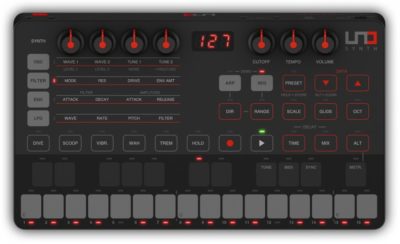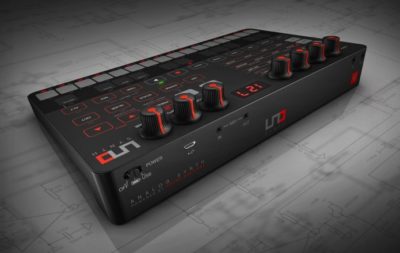New Gear Review: UNO Synth by IK Multimedia

Marking their first foray into the synthesizer world, IK Multimedia debuts the ultra-portable, true analog UNO Synth.
A decade ago, if you were in the market for a new dual-oscillator analog synthesizer, your choices were likely dictated by what was listed on eBay at the moment.
These days, that is no longer the case, as the market for modern desktop synths continues to expand.
But that variety of choice also means that music equipment manufacturers are taking this small but mighty slice of the market very seriously, as it not only includes professional touring musicians looking for gear to spice up their live rig, but amateurs and hobbyists as well, who have only heard analog synths processed and recorded.
Into that milieu arrives the latest offering from IK Multimedia, an Italian brand with a history of forward-thinking products that always aim to serve unique and specific needs. Case in point: their ubiquitous iRig series, with which IK saw the rise of iOS apps in music production and leapt quickly to develop a solution.
The UNO Synth, which arrived earlier this summer, is the company’s first synthesizer offering, and was designed in conjunction with Erik Norlander (one of the brains behind the Alesis Andromeda). A pairing this deft was bound to produce intriguing results, as the UNO’s unique feature set proves.
Features
Similar to Novation’s Circuit Mono Station, the UNO holds more complexity within its grey plastic body than you may think upon first glance. 7 knobs sit atop the unit, which is angled for maximum playability. A row of 27 keys at the bottom allow the inputting of notes, but as these buttons are not velocity sensitive, hooking up a MIDI controller of some kind is necessary to tap into the full scope of the UNO’s sonic abilities. And those sonic abilities are plentiful due to IK and Norlander’s many unique design choices in the synth’s architecture.
At its core, the UNO uses two oscillators that can be independently tuned and fed into a mixer, along with a variable noise level. These mixer controls are the only ones that are hidden behind a shift function (holding the OSC button for a second activates mixer volume levels).
Nearly every parameter is available via a grid-based system that will be familiar to anyone who has used a Microkorg, Blofeld, or Ultranova. The key word here is nearly, because the UNO hides a few key parameters inside its included Editor, which we will get further into later.
The synth architecture is worth focusing on as there are a few nice details that really make the UNO a versatile studio instrument. Taking a page from Moog’s book, each oscillator has variable wave shaping, meaning it can move fluidly between triangle, sawtooth, square wave, and pulse width shapes. Another nice touch is the multi-mode filter, complete with drive control and a dedicated cutoff knob that begs for live tweaking.
There’s a delay at the end of the signal chain, as well as a simple but capable 16-step sequencer, and an arpeggiator with a healthy selection of direction choices. Finally, buttons for “glide” and “octave” round out the physical controls, both ergonomically placed and easy to hit when needed—though there’s something not quite as rewarding about changing the value of portamento via a push button interface.
In Use
Digging into the 100 presets—80 of which can be overwritten by the user—reveals juicy basses, solid resonant zaps, dreamy leads, interval pads, and even noisy sound effects. The versatility of the UNO is impressive, and is where the expertise of Norlander’s veteran touch can really be felt.
The multi-mode filter, variable wave shapes, and drive control amount to a very capable instrument that is complemented by 6 performance buttons placed directly above the keyboard. These allow quick access to things like dive or scoop pitch bends, or modulation-based effects like wah and tremolo. Unfortunately, the depth of these effects can’t be controlled via the UNO itself, which brings us to the included Editor that IK Multimedia has bundled, where variable depth control for these functions is available.
The Editor also acts as a real-time control panel for the synth, giving you the ability to clearly visualize what is going on under the hood. Editing, saving, and recalling patches is also possible, and there are settings for things like MIDI channel and knob behavior. You also gain access to full ADSR controls for both the filter and amp, as well as controls for setting the velocity’s effect on the amp, filter, filter envelope, and even LFO rate. The fact that the Editor also includes a handy on-screen keyboard, and is capable of being run on both a computer and iOS devices, makes it a huge bonus.
To Be Critical
There’s so much to like about the UNO that its few shortcomings were immediately very clear to me. For instance, the physical unit itself doesn’t inspire much in the way of confidence or creativity, as its nearly 2D design and low-tech graphics make it look more like an office calculator than an analog synthesizer.
Furthermore, the keys weren’t the most responsive, especially when played quickly. However, given the fact that there’s a MIDI input, I don’t see this as a crippling issue. It’s also worth mentioning that the cutoff and resonance controls on the multi-mode filter are set physically far apart on the unit, which does take a bit of getting used to.
Summing it Up
Overall, there’s a lot to like about IK Multimedia’s UNO Synth, especially considering it’s priced at $199. An analog synth with a two-oscillator design, paired with a nice, driven filter and a sequencer and arpeggiator? It almost seems too good to be true.
Similar to my reaction upon the release of Korg’s diminutive Volca Bass and Keys mini-synths, the more time I spent with the UNO, the more I realized its power. The UNO Synth is a must-buy if you’re looking for a portable, flexible analog synthesizer that will keep you busy for many sessions to come.
Leo Maymind is a producer, DJ, and writer living in Los Angeles, CA. He is obsessed with sound, and you can reach him at lmaymind@gmail.com.
Please note: When you buy products through links on this page, we may earn an affiliate commission.







